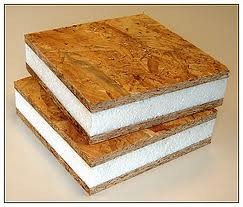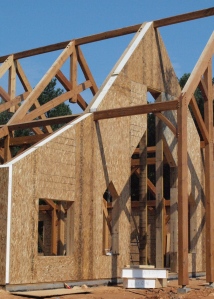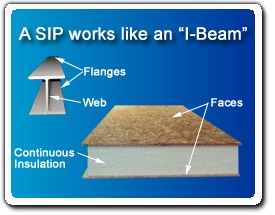Structural Insulated Panels (SIPs)

Structural Insulated Panels (SIPs)
Structural Insulated Panels, usually abbreviated as SIPs, are gaining in popularity among builders and homeowners for a variety of reasons. What exactly are SIPs, and how can they be used as part of an overall green home design? We'll look at some of the ways SIPs are changing home construction for the greener.
What is a SIP?
Structural insulated panels consist of a foam core sandwiched between two facings which are usually made of oriented strand board (OSB). They are precision-manufactured in a factory setting, and can be sized to fit any design.
Green Advantages of SIPs
SIPs are a high-performance system; they are very strong, cost effective, and energy-efficient.Energy Savings
For green homeowners, the main advantage of using SIPs is their extreme efficiency. Homes built with SIPs can be expected to use about half the energy of conventional stick-built homes with traditional wall insulation. Studies have show that a 4-inch SIP wall rated at R-14 insulates better than a 2x6 stick-frame wall with R-19 fiberglass batt insulation.
Blower door testing has indicated that SIP walls are 15 times more airtight than similar walls built with traditional stick-framing and fiberglass insulation. This high level of performance comes from the continuous insulation of a SIP's foam insulating core. The thermal bridging from studs placed every 16 to 24 inches in a stick frame leads to considerable energy loss; SIPs eliminate thermal bridging as well as the gaps and voids that are common in more traditional insulations.
The superior insulation performance of SIPs also allows homes to heat and cool with smaller HVAC systems, which also reduces overall energy usage.
Building with SIPs earns LEED points for green home certification.

Indoor Air Quality
SIPs also contribute to a healthier indoor air environment. A more airtight structure is better at controlled ventilation and limiting incoming air. Controlled ventilation through an HVAC system filters indoor allergens and contaminants and dehumidifies incoming air, reducing moisture and mold growth.
SIPs contain no VOCs or other dangerous chemicals that can affect indoor air quality. The EPS foam uses pentane, a non-CFC gas that dissipates soon after production, with no off-gassing when installed. The OSB board is made with no urea formaldehyde adhesives and meets or exceeds standards for formaldehyde emissions. The adhesives used in SIP production have no measurable amounts of VOCs.
Fewer Resources
Manufacturing SIPs requires less energy and raw materials than other structural systems.
The wood in the OSB board comes from fast-growing wood grown in managed forests. Up to 90% of the tree can be used in making SIPs, with the waste being used for energy or pulp chips.
The EPS foam insulation is mostly air; in fact, EPS contains only 2% plastic. The energy-saving performance of the SIP wall saves many times the energy embodied in the making of the SIP itself.
Producing EPS foam requires 24% less energy than fiberglass insulation, and any scrap EPS leftover can be recycled into new EPS products.
Since SIPs are made and cut to order in a controlled environment using sophisticated software and automated fabrication technology, they can drastically reduce the amount of waste generated by construction.
Further Advantages of SIPs

SIPs are much stronger than traditional framing and can cost less to insure in high wind areas due to this greater strength.
SIPs can be utilized in any design, including open designs with long roof spans.
The continuous foam core insulation inside the SIP provides superior noise insulation, reduced drafts, and a consistent indoor temperature.
SIPs: The Green Advantage
When you consider the tremendous energy savings SIPs provide, the reduction in construction waste and sustainable manufacturing practices, SIPs are a very formidable green building material.comments powered by Disqus


























































































































































































